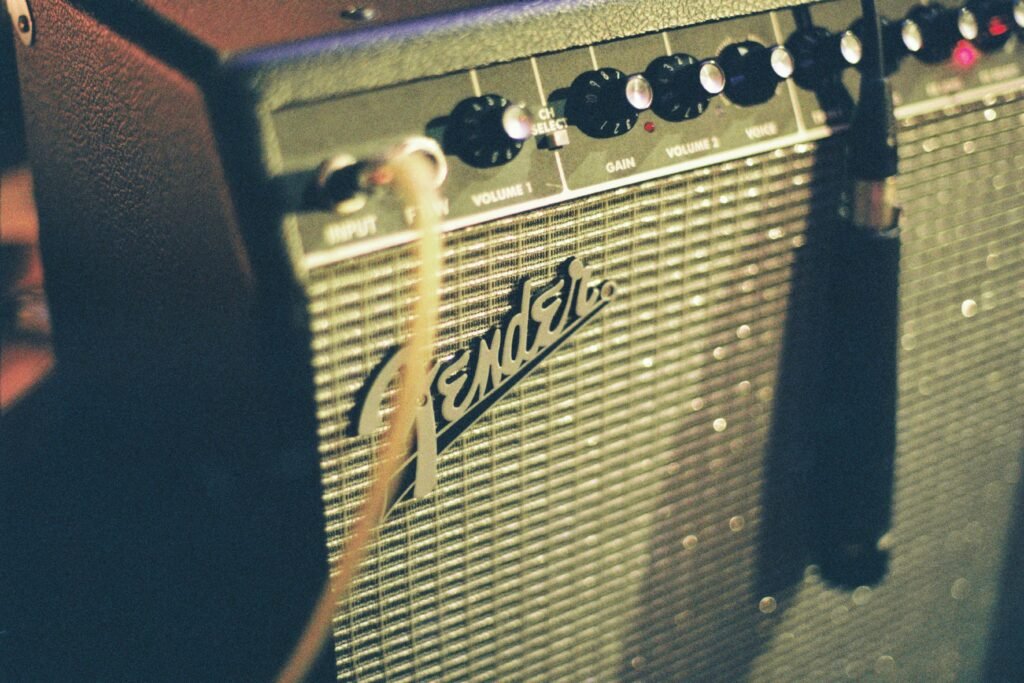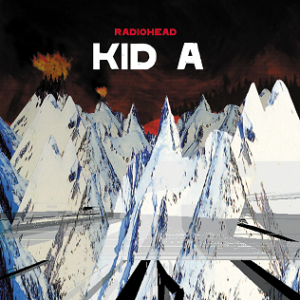Released in October 2000, Kid A marked a radical shift in Radiohead’s trajectory, positioning the band as pioneers willing to dismantle the conventions of alternative rock just when they’d established themselves as one of its defining forces. This album followed the massive success of OK Computer (1997), an album lauded for its dark, textured take on guitar-driven rock with lyrics exploring alienation and a burgeoning digital age.
Rather than expand on this formula, Kid A pivoted sharply, embracing electronic, ambient, and avant-garde elements, pulling from influences as varied as Aphex Twin, Can, and Miles Davis. The result was not only a significant departure from Radiohead’s previous sound but a work that reshaped the direction of rock at the turn of the millennium.
Artistic Intentions
The artistic intentions behind Kid A were bold and unapologetic. Frontman Thom Yorke has described the album as a response to the exhaustion and existential disillusionment that set in after OK Computer’s massive tour and success. The album’s abstract and often unsettling textures reflect Yorke’s inner turbulence and his dissatisfaction with the traditional band structure.
Kid A emerged from a process of decomposing the ego of rock, largely abandoning the guitar as the core instrument, and immersing the listener in a world of manipulated vocals, synthesized landscapes, and layered sonic experimentation. In creating Kid A, Radiohead sought to dissolve the boundaries between digital and organic, challenging the listener to reconsider what an album could be and, by extension, where music itself could go.
Sonic Exploration

Kid A is a masterclass in meticulous, atmospheric production, designed as much for headphone immersion as it is for large speakers. The album’s sonic landscape feels both vast and claustrophobic, an intentional paradox crafted by producer Nigel Godrich, who worked closely with the band to dismantle and rebuild Radiohead’s sound from the ground up. Instead of the crisp, almost sterile precision typical of rock albums in the late ’90s, Kid A embraces a textural, layered production that feels almost as if the listener is eavesdropping on a soundscape in flux.
From the hollowed echo of Yorke’s vocals in “How to Disappear Completely” to the skittering drum machine on “Idioteque,” the production immerses the listener in a ghostly, glitch-ridden world. Each sound feels intentional, chosen to enhance the album’s fragmented, dystopian themes.
Musical Arrangements
Musically, Kid A abandons many of the standard rock structures and embraces a more deconstructed approach, where instruments emerge and fade with haunting unpredictability. Jonny Greenwood’s guitar, once the backbone of Radiohead’s sound, is often buried or even replaced by synthesizers and processed samples, leaving fans grasping at the occasional fragments of melody. “Everything in Its Right Place” opens the album with layers of distorted keyboards and Yorke’s vocals digitally chopped, creating an unnerving sense of dislocation.
The arrangement of “The National Anthem” stands out as one of the album’s boldest experiments, with Greenwood’s snarling bass line anchoring a wall of chaotic, freeform jazz horns that veer into dissonance, giving the song an ominous, urban intensity. Meanwhile, songs like “Motion Picture Soundtrack” channel a dark, theatrical quality with minimalist organ and harp-like samples, evoking a sense of bleak reverie.
Genre Elements
Radiohead’s genre-spanning approach on Kid A is part of what makes it such a milestone. The album defies easy classification, drawing from electronica, krautrock, ambient, jazz, and even post-rock, fusing these influences into a singular, almost unclassifiable sound. Tracks like “Idioteque” pull from IDM and glitch music, while “Treefingers” floats in ambient soundscapes reminiscent of Brian Eno. This blend wasn’t just genre-hopping for novelty’s sake; it was Radiohead reimagining the future of rock by pushing it beyond its roots, challenging listeners to redefine their expectations. In its daring fusion of electronic and analog, digital and human, Kid A broke boundaries, paving the way for a generation of genre-blurring music to come.
Lyrical Analysis

The lyrics of Kid A are sparse, cryptic, and fragmented, yet this ambiguity is central to the album’s emotional and thematic resonance. Unlike the more direct social and existential musings of OK Computer, Kid A eschews clear narratives, opting for disjointed phrases and fragmented imagery that evoke a sense of alienation and unreality. Thematically, the album circles around disconnection, dystopia, and the anxieties of a digital age. The lyrics frequently explore themes of identity dissolution, societal numbness, and isolation, as if reflecting a mind trying to process a world that no longer feels coherent.
Recurring motifs of dislocation, disintegration, and existential dread appear throughout. In “Everything in Its Right Place,” Yorke’s repetitive lines—“Yesterday I woke up sucking a lemon”—capture a mundane yet deeply unsettling frustration, expressing a sense of emotional stasis. Meanwhile, “How to Disappear Completely” is almost a meditation on invisibility, with Yorke’s desolate refrain “I’m not here, this isn’t happening” evoking a yearning to escape from reality itself. These lyrics give voice to an emotional void, an urge to disconnect in response to overwhelming forces beyond personal control.
Lyrical Depth
The lyrics are as complex as they are poetic, crafted with a minimalist approach that lends itself to multiple interpretations. Radiohead seems deliberately abstract here, with Yorke channeling feelings rather than fully-formed thoughts, using language that feels more like stream-of-consciousness than a conventional song structure. This abstraction allows listeners to project their own anxieties, fears, and disconnections onto the songs, making the album an almost interactive emotional experience. Songs like “Idioteque” blend anxious, staccato phrases like “Ice age coming, let me hear both sides” to paint a picture of looming catastrophe, yet the lyrics remain open-ended, letting the listener choose the source of the impending collapse—be it personal, societal, or environmental.
Emotional Impact
Emotionally, Kid A’s lyrics are bleak, even haunting, contributing to the album’s sense of dread and contemplation. There’s a pervasive sadness in Yorke’s delivery, but also a numbness, as if he is observing these feelings from a distance. This detached lyricism amplifies the sense of isolation that pervades the album, creating a landscape where the human experience seems at once hyperconnected and hopelessly adrift. Rather than pulling the listener into a cathartic release, Kid A’s lyrics linger in ambiguity and introspection, leaving listeners with more questions than answers. It’s this emotional restraint—this refusal to resolve or explain—that makes Kid A such a hauntingly resonant album, a work that captures the emotional uncertainties of a new millennium.
Cohesion and Flow

One of Kid A’s most remarkable achievements is its seamless cohesion, where each track flows into the next with a deliberate, almost hypnotic momentum. The album feels less like a collection of songs and more like a continuous, immersive experience, with each track serving as a chapter in an abstract narrative. From the very first notes of “Everything in Its Right Place,” Kid A sets a disorienting tone that carries through the entire album, pulling the listener deeper into its surreal, digital landscape with each passing track.
This fluid progression is intentional: tracks seem to dissolve into one another, often without noticeable pauses, creating an uninterrupted stream of sound that blurs the lines between individual songs. For example, the ambient “Treefingers” slips almost unnoticed into the pulse of “Optimistic,” bridging the gap between eerie soundscapes and more rhythm-driven tracks.
Thematic Consistency
The album’s thematic consistency is another testament to its carefully constructed flow. Themes of alienation, anxiety, and existential searching are threaded through each track, not only lyrically but through tone, pacing, and instrumentation. Kid A never deviates from its commitment to exploring these darker territories. Even songs that differ in tempo or arrangement—like the jazz-inflected chaos of “The National Anthem” and the glacial minimalism of “Motion Picture Soundtrack”—still feel interconnected by the same underlying mood and intent. This tonal unity allows the album’s stylistic diversity to come across as natural exploration rather than jarring divergence. Every sonic experiment serves the larger emotional arc, ensuring that Kid A’s avant-garde moments enhance rather than disrupt its cohesion.
Emotionally, Kid A follows a subtle progression, as if moving from an initial disorientation toward something vaguely redemptive, though not wholly resolved. The album begins with a sense of fractured reality in “Everything in Its Right Place” and “Kid A,” exploring themes of paranoia and dissociation. Tracks in the middle, like “How to Disappear Completely” and “Idioteque,” delve into a kind of existential panic and environmental dread.
By the time we reach “Motion Picture Soundtrack,” there’s a sense of weary acceptance, as the album closes with orchestral flourishes that feel almost like a requiem for human connection in a cold, digital world. This progression is subtle, less of a straightforward story and more of an emotional journey, yet it gives Kid A an undeniable sense of purpose and direction.
Standout Tracks and Moments
While Kid A is often lauded as an immersive experience best appreciated as a whole, several tracks stand out as pivotal moments within the album, either for their innovation, emotional intensity, or sheer boldness. Among these, “Everything in Its Right Place,” “Idioteque,” and “How to Disappear Completely” emerge as the album’s emotional and sonic cornerstones, each pushing Radiohead’s sound and vision into uncharted territory.
Everything in Its Right Place
“Everything in Its Right Place” opens the album with a chilling clarity, setting the stage for the alien landscapes to follow. The song is built around warped keyboards and Yorke’s heavily manipulated vocals, which loop and overlap, creating a sense of surrealism and repetition that evokes a trapped mind. The repeated phrase “Yesterday I woke up sucking a lemon” seems almost nonsensical yet powerfully unsettling, immediately conveying the album’s fractured emotional state. This song is a testament to Radiohead’s departure from traditional rock structures, signaling that Kid A will not be a comfortable listen, but rather a deep dive into discomfort and introspection.
Idioteque
“Idioteque” is another standout, embodying the album’s raw, electronic pulse. Propelled by a jittery, industrial beat and urgent, fragmented lyrics, the track feels like an anthem for a world on the edge of collapse. Yorke’s lyrics—“Ice age coming, ice age coming”—tap into a sense of impending environmental and societal doom, while the frenetic rhythms evoke the chaos of modern life.
The track’s use of electronic sampling, reportedly pulled from experimental electronic sources, stands as one of the album’s boldest innovations, pulling the listener into an almost panicked state that mirrors its themes of instability. “Idioteque” is perhaps Kid A’s most accessible track in terms of beat, yet its relentless anxiety and stark warnings make it one of Radiohead’s darkest statements.
How to Disappear Completely
“How to Disappear Completely” is the emotional core of Kid A, capturing a deep sense of alienation and desolation. Built on a haunting mix of acoustic guitar, strings, and a hypnotic bassline, it’s a moment of aching vulnerability amidst the album’s digital landscapes. Yorke’s refrain, “I’m not here, this isn’t happening,” is delivered with haunting fragility, perfectly encapsulating the theme of dissociation that pervades the album. The orchestration here, arranged by Jonny Greenwood and inspired by Polish composer Krzysztof Penderecki, enhances the song’s eerie, cinematic quality. This track’s ethereal arrangement and Yorke’s pained delivery make it one of Radiohead’s most affecting pieces, a song that resonates long after it ends.
Memorable Moments
The album is also marked by several memorable moments that crystallize Kid A’s essence. In “The National Anthem,” Greenwood’s aggressive, repetitive bassline gradually becomes engulfed in a storm of freeform jazz horns—a chaotic, claustrophobic wall of sound that mirrors urban anxiety and information overload. This moment captures Radiohead’s willingness to embrace dissonance and unpredictability, challenging listeners with a collision of jazz and noise rock that feels both invigorating and unsettling.
“Motion Picture Soundtrack,” which closes the album, offers a moment of eerie, melancholy beauty that stands in contrast to the digital coldness of much of the album. The use of ghostly organ and synthetic harp sounds, coupled with Yorke’s wistful lyrics, creates the sensation of a weary epilogue—a farewell to the emotional journey that Kid A has charted. When Yorke sings, “I will see you in the next life,” over the orchestral swells, it feels like the album’s most human moment, tinged with both resignation and a glimmer of hope.
Artistic Contribution and Innovation

Upon its release, Kid A was nothing short of a seismic shift within both the rock genre and the broader music industry. It arrived at a time when alternative rock still dominated, following the post-grunge, Britpop, and alt-rock wave of the ’90s, and bands like Radiohead were expected to double down on their success by delivering the guitar-driven sound fans had come to love. Instead, Radiohead rejected these norms entirely, pulling away from traditional rock and into experimental, electronic territory. This leap not only subverted expectations but also redefined what a mainstream rock band could be, influencing countless artists across genres and inspiring a generation to push beyond the constraints of genre and audience expectations.
Kid A’s innovation lies in its fearless dismantling of rock conventions, embracing elements that few bands of its stature had ventured into at the time. It’s not that electronic influences were new to music, but Radiohead’s approach to integrating glitchy beats, ambient soundscapes, and minimalist arrangements was groundbreaking for a band that had risen to fame through traditional guitar-driven compositions. They drew from IDM (Intelligent Dance Music), ambient, and krautrock, weaving these influences into an album that felt alien, modern, and organic all at once. In doing so, Kid A essentially merged electronic and rock music in a way that was approachable but unflinching, helping to blur the line between genres in the 2000s and beyond.
Production
The album’s production also represents a significant innovation. Rather than opting for a pristine or polished sound, Radiohead and producer Nigel Godrich embraced a more experimental, almost collage-like approach, allowing for textures that feel raw, murky, and at times unsettling. Techniques like manipulated vocals, looping, and layering create an atmosphere that feels as though it’s in constant flux—alive and, in many ways, uneasy. This production style has since become a hallmark of Radiohead’s music and has inspired many artists in electronic and alternative genres who seek to add organic depth to digital soundscapes.
Themes
Lyrically and thematically, Kid A also stands as a blueprint for exploring existential and societal dread. Thom Yorke’s lyrics are purposely fragmented, like scrambled signals from a world falling apart. This lyrical abstraction was a bold departure, allowing listeners to engage with the themes more personally, inserting their own anxieties and interpretations. By tackling issues like alienation, disconnection, and the encroaching influence of technology with such openness to interpretation, Kid A transcended its era, remaining relevant and resonant in an increasingly digital world.
Experimental
In an era before streaming, Kid A’s success as an experimental album also challenged the industry’s commercial standards. Rather than promoting it heavily with singles or music videos, the band largely withheld from traditional marketing, even abstaining from releasing any official singles in the U.S. This decision was almost unheard of for a major-label act, yet the album debuted at No. 1 in multiple countries, demonstrating a hunger for more adventurous, complex work among listeners. In this way, Kid A became a cultural phenomenon and a touchstone for independent and experimental artists who saw in it a path to success outside the traditional commercial formulas.
Closing Thoughts

Kid A is a masterful, boundary-pushing album that cemented Radiohead’s position as one of the most innovative bands of their generation. Its strengths lie in its fearless abandonment of genre norms, its richly layered production, and its abstract approach to lyricism, which invites listeners to confront their own anxieties within its surreal, dystopian world. The album’s experimental nature, which mixes electronica, rock, and avant-garde influences, creates a unique soundscape that’s both hauntingly beautiful and eerily detached, capturing the discomfort of a rapidly changing world. It challenged listeners and critics alike to reconsider what rock could be and sparked a wave of genre-blurring experimentation across the industry.
While some may view Kid A’s refusal to deliver easy hooks or accessible lyrics as a drawback, it is this very commitment to artistic risk that defines the album’s enduring power. Radiohead didn’t set out to please with Kid A; they set out to express a deeper, darker experience of modern existence. The result is a work that rewards patience and contemplation, inviting listeners into an immersive journey rather than offering quick satisfaction. This may make it a difficult listen for some, but it’s precisely what has ensured its status as a groundbreaking and essential album that grows more relevant with each passing year.
Place in Career
As for its place in Radiohead’s career, Kid A stands as a defining moment, a testament to their willingness to evolve and take creative risks, even at the height of their popularity. It redefined their legacy and demonstrated that mainstream success need not be synonymous with creative compromise. In many ways, Kid A is Radiohead’s magnum opus, and its influence can be seen in the work of countless artists who followed, from electronic to alternative rock to experimental pop.
Official Rating
Kid A deserves a 10 for its fearless vision, emotional resonance, and transformative impact on music. It is an album that refuses easy categorization, transcending its era to remain both timeless and perpetually forward-looking. By shattering expectations and redefining genre boundaries, Kid A established itself as a true work of art—an achievement in sound and concept that continues to inspire and challenge. For these reasons, it earns a perfect score, as both a landmark in Radiohead’s discography and a pivotal moment in the evolution of modern music.
